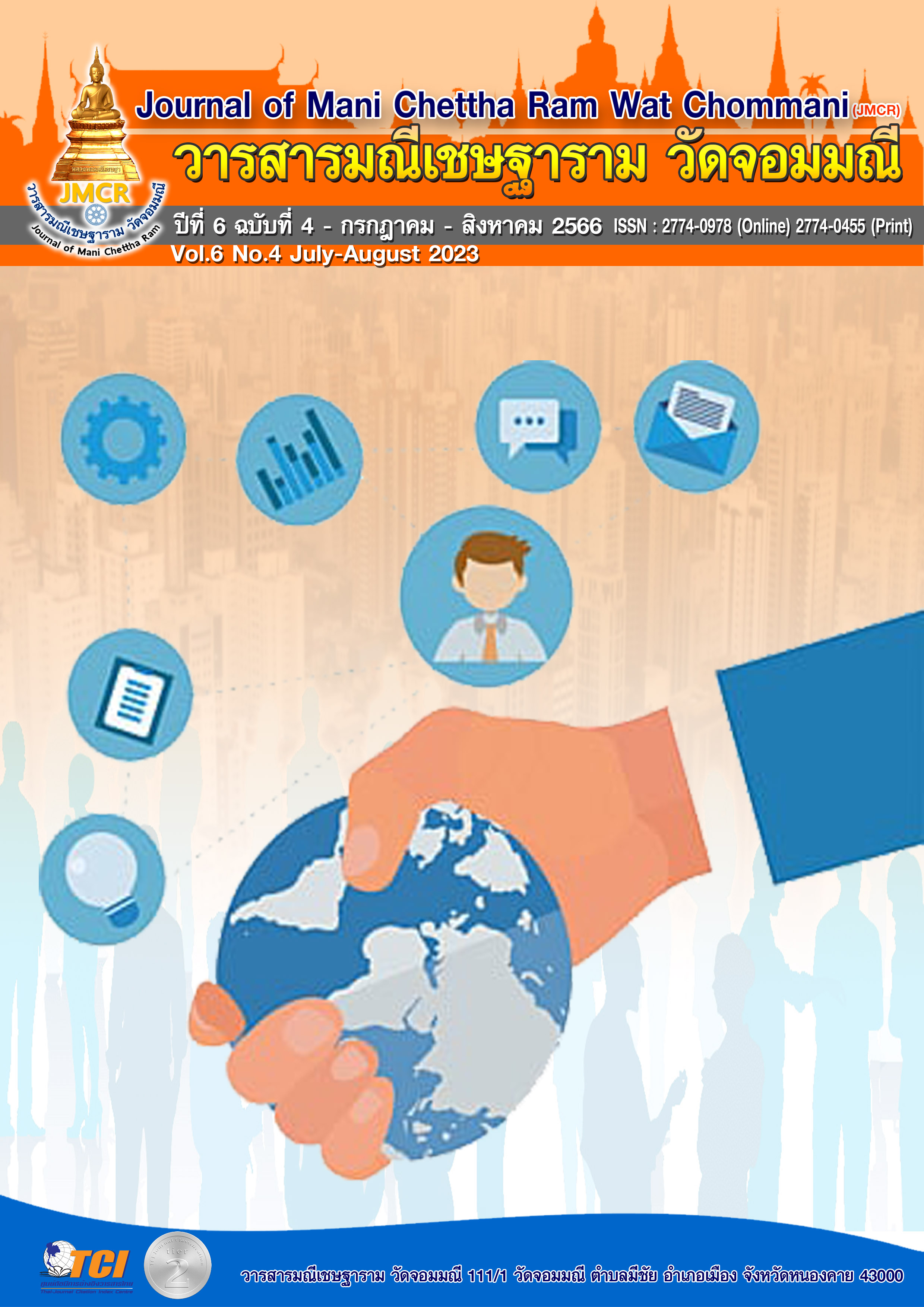ภาวะผู้นำทางเทคโนโลยีของผู้บริหารสถานศึกษาที่ส่งผลต่อ ประสิทธิผลการบริหารงานในโรงเรียนสังกัดสำนักงานเขตพื้นที่การศึกษามัธยมศึกษาหนองคาย
คำสำคัญ:
ภาวะผู้นำทางเทคโนโลยี, ประสิทธิผลการบริหารงานบทคัดย่อ
ปัจจุบันเทคโนโลยีเข้ามามีบทบาทในชีวิตเรามากขึ้น รูปแบบการใช้ชีวิตของคนในสังคมก็เปลี่ยนแปลง การปรับตัวในยุคสมัยที่เปลี่ยนไปและความก้าวหน้าทางเทคโนโลยีที่เข้ามามีอิทธิพลกับการใช้ชีวิตแทบจะทุกช่องทาง นับได้ว่าเป็นยุคแห่งเทคโนโลยี ซึ่งต้องยอมรับว่าเราทุกคนจะต้องมีการพัฒนาและปรับตัวตามกระแสความเปลี่ยนแปลงของสังคมโลก ซึ่งการวิจัยครั้งนี้มีวัตถุประสงค์ (1) เพื่อศึกษาระดับภาวะผู้นำทางเทคโนโลยีของผู้บริหารสถานศึกษาในโรงเรียนสังกัด สำนักงานเขตพื้นที่การศึกษามัธยมศึกษาหนองคาย (2) เพื่อศึกษาระดับประสิทธิผลการบริหารงานในโรงเรียนสังกัดสำนักงานเขตพื้นที่การศึกษามัธยมศึกษาหนองคาย (3) เพื่อศึกษาความสัมพันธ์ระหว่างภาวะผู้นำทางเทคโนโลยีของผู้บริหารสถานศึกษากับประสิทธิผลการบริหารงานในโรงเรียนสังกัดสำนักงานเขตพื้นที่การศึกษามัธยมศึกษาหนองคาย (4) เพื่อศึกษาภาวะผู้นำทางเทคโนโลยีของผู้บริหารสถานศึกษาที่ส่งผลต่อประสิทธิผลการบริหารงานในโรงเรียนสังกัดสำนักงานเขตพื้นที่การศึกษามัธยมศึกษาหนองคาย กลุ่มตัวอย่างที่ใช้ในการวิจัยครั้งนี้ คือ ผู้บริหาร และครูในโรงเรียนสังกัดสำนักงานเขตพื้นที่การศึกษามัธยมศึกษาหนองคาย จำนวน 288 คน เครื่องมือที่ใช้ใน การวิจัยเป็นแบบสอบถามประมาณค่า 5 ระดับ มีค่าความเชื่อมั่นภาวะผู้นำทางเทคโนโลยีของผู้บริหารสถานศึกษา เท่ากับ 0.958 ค่าความเชื่อมั่นประสิทธิผลการบริหารงานในโรงเรียน เท่ากับ 0.966 สถิติที่ใช้ในการวิเคราะห์ข้อมูลสถิติเชิงบรรยาย ได้แก่ ค่าความถี่ ค่าร้อยละ ค่าเฉลี่ย ค่าเบี่ยงเบนมาตรฐาน สถิติอนุมาน ได้แก่ ค่าสัมประสิทธิ์สหสัมพันธ์ของเพียร์สัน วิเคราะห์ถดถอยพหุคูณ โดยใช้วิธี Stepwise เพื่อดูตัวแปรที่มีนัยสำคัญ และนำค่าสถิติที่ได้ไปสร้างสมการพยากรณ์ ผลการวิจัยพบว่า 1. ระดับภาวะผู้นำทางเทคโนโลยีของผู้บริหารสถานศึกษาสังกัดสำนักงานเขตพื้นที่การศึกษามัธยมศึกษาหนองคาย โดยรวมอยู่ในระดับมาก 2. ระดับประสิทธิผลการบริหารงานในโรงเรียนสังกัดสำนักงานเขตพื้นที่การศึกษามัธยมศึกษาหนองคายโดยรวมอยู่ในระดับมาก 3. ความสัมพันธ์ระหว่างภาวะผู้นำทางเทคโนโลยีของผู้บริหารสถานศึกษากับประสิทธิผลการบริหารงานในโรงเรียนสังกัดสำนักงานเขตพื้นที่การศึกษามัธยมศึกษาหนองคาย โดยใช้การทดสอบค่าสถิติสัมประสิทธิ์สหสัมพันธ์ ของ Pearson (Pearson’s Product Moment Correlation Coefficient) โดยรวมมีค่า ในระดับสูง เท่ากับ 0.795 ซึ่งมีความสัมพันธ์ในเชิงบวกหรือในทิศทางเดียวกัน อย่างมีนัยสำคัญทางสถิติเท่ากับ .01 4. การวิเคราะห์ภาวะผู้นำทางเทคโนโลยีของผู้บริหารสถานศึกษาที่ส่งผลต่อประสิทธิผลการบริหารงานในโรงเรียนสังกัดสำนักงานเขตพื้นที่การศึกษามัธยมศึกษาหนองคาย ดังนี้ ภาวะผู้นำทางเทคโนโลยีของผู้บริหารสถานศึกษา ที่นำมาวิเคราะห์ จำนวน 5 องค์ประกอบ มีอำนาจพยากรณ์ ประสิทธิผลการบริหารงานในโรงเรียนสังกัดสำนักงานเขตพื้นที่การศึกษามัธยมศึกษาหนองคาย โดยรวมได้อย่างมีนัยสำคัญทางสถิติที่ระดับ .05
เอกสารอ้างอิง
ชัญญาภัค ใยดี. (2561). การศึกษาแนวทางการพัฒนาภาวะผู้นำด้านเทคโนโลยีของผู้บริหารสถานศึกษา สังกัดองค์การบริหาร ส่วนจังหวัดนครราชสีมา. วารสารดุษฎีบัณฑิตทางสังคมศาสตร์, 8 (1), 150-164.
ชัยนาม บุญนิตย์. (2563). ภาวะผู้นำทางเทคโนโลยีและนวัตกรรมของผู้บริหารสถานศึกษา สังกัดสำนักงานเขตพื้นที่การศึกษาประถมศึกษาสุโขทัย เขต 2. ใน วิทยานิพนธ์ปริญญาครุศาสตรมหาบัณฑิต สาขาวิชาการบริหารการศึกษา. มหาวิทยาลัยราชภัฏอุตรดิตถ์.
จุรีรัตน์ ม่วงนา. (2563). ภาวะผู้นำเชิงกลยุทธ์ของผู้บริหารกับประสิทธิผลของโรงเรียน สังกัดสำนักงานเขตพื้นที่การศึกษามัธยมศึกษา เขต 8. ใน วิทยานิพนธ์ ศึกษาศาสตรมหาบัณฑิต สาขาวิชาการบริหารการศึกษา. มหาวิทยาลัยศิลปากร.
นิศาชล บำรุงภักดี. (2563). ความสัมพันธ์ระหว่างภาวะผู้นำทางเทคโนโลยีสารสนเทศของผู้บริหารสถานศึกษากับประสิทธิผลโรงเรียน ในสังกัดองค์กรปกครองส่วนท้องถิ่นจังหวัดสกลนคร. ใน วิทยานิพนธ์ศึกษาศาสตรมหาบัณฑิต. สาขาวิชาการบริหารการศึกษา มหาวิทยาลัยราชภัฏสกลนคร.
ศึกษาธิการ, กระทรวง. 2546. พระราชบัญญัติการศึกษาแห่งชาติ พ.ศ.2542 และที่แก้ไขเพิ่มเติม (ฉบับที่2) พ.ศ. 2545. กรุงเทพมหานคร: กระทรวงศึกษาธิการ.
ฉัตรพงศ์ ชูแสงนิล. (2564). ความฉลาดทางดิจิทัล (Digital intelligence). เรียกใช้เมื่อ 15 มิถุนายน 2564, จาก https://www.scimath.org/article-technology/item/10611-digital-intelligence
บารมี จรัสสิงห์. (2560). การบริหารคุณภาพองค์กร. เรียกใช้เมื่อ จากhttps://plan.dmh.go.th/.
วิโรจน์ สารรัตนะ. (2556). กระบวนทัศน์ใหม่ทางการศึกษา กรณีทัศนะต่อการศึกษาศตวรรษที่
พิมพ์ครั้งที่ 1. กรุงเทพมหานคร: ทิพยวิสุทธิ์.
______. (2542). การบริหาร หลักการ ทฤษฎี และประเด็นทางการศึกษา. กรุงเทพมหานคร :ทิพยวิสุทธิ์.
สุพริศร์ สุวรรณิก. (2563). โลกจะเปลี่ยนไปอย่างไร หลังวิกฤตโควิด-19 จบลง?. เรียกใช้เมื่อ 1 มีนาคม 2564, จากhttps://www.bot.or.th/Thai/ResearchAndPublications/articles/Pages/Article_30Mar2020.aspx
Krejcie, R.V., & D.W. Morgan. (1970). Determining Sample Size for Research Activities. Educational and Psychological Measurement. 30(3) : 607 – 610.
Pearson, K. (1920). Notes on the history of correlation. Biometrika, 13(1), 25-45.


